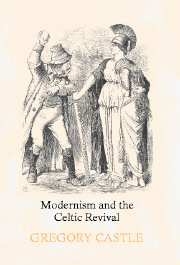Book contents
- Frontmatter
- Contents
- Acknowledgments
- List of abbreviations
- 1 The Celtic muse: anthropology, modernism, and the Celtic Revival
- 2 “Fair equivalents”: Yeats, Revivalism, and the redemption of culture
- 3 “Synge-On-Aran”: The Aran Islands and the subject of Revivalist ethnography
- 4 Staging ethnography: Synge's The Playboy of the Western World
- 5 “A renegade from the ranks”: Joyce's critique of Revivalism in the early fiction
- 6 Joyce's modernism: anthropological fictions in Ulysses
- Conclusion: After the Revival: “Not even Main Street is Safe”
- Notes
- Select bibliography
- Index
3 - “Synge-On-Aran”: The Aran Islands and the subject of Revivalist ethnography
Published online by Cambridge University Press: 24 November 2009
- Frontmatter
- Contents
- Acknowledgments
- List of abbreviations
- 1 The Celtic muse: anthropology, modernism, and the Celtic Revival
- 2 “Fair equivalents”: Yeats, Revivalism, and the redemption of culture
- 3 “Synge-On-Aran”: The Aran Islands and the subject of Revivalist ethnography
- 4 Staging ethnography: Synge's The Playboy of the Western World
- 5 “A renegade from the ranks”: Joyce's critique of Revivalism in the early fiction
- 6 Joyce's modernism: anthropological fictions in Ulysses
- Conclusion: After the Revival: “Not even Main Street is Safe”
- Notes
- Select bibliography
- Index
Summary
Islanders too
are for sculpting. Note
the pointed scowl, the mouth
carved as upturned anchor
and the polished head full of drownings.
There
he comes now, a hard pen
scraping in his head;
the nib filed on a salt wind
and dipped in the keening sea.
Seamus HeaneyIn his Introduction to The Aran Islands, John M. Synge writes, “In the pages that follow I have given a direct account of my life on the islands, and of what I met with among them, inventing nothing, and changing nothing that is essential” (AI, 48). This disclaimer might well serve as an expression of the attitude toward culture that was emerging among anthropologists like A. R. Radcliffe-Brown and Bronislaw Malinowski in the first decades of the twentieth century. At the same time, it raises questions about representation that are central to ethnography and that deepen the difficulties of establishing rapport and credibility with native communities. Synge strove to establish himself among the Aran Islanders and managed to establish the distance proper to ethnographic observation and to write something like an ethnographic account. But this account is destabilized in ways that suggest a modernist sensibility at odds with the mode of ethnographic redemption that has been called into being as an anodyne for his sense of dissociation and alienation. In this respect, Synge's Aran Islands develops still further certain aspects of Yeats's Revivalist project.
- Type
- Chapter
- Information
- Modernism and the Celtic Revival , pp. 98 - 133Publisher: Cambridge University PressPrint publication year: 2001



